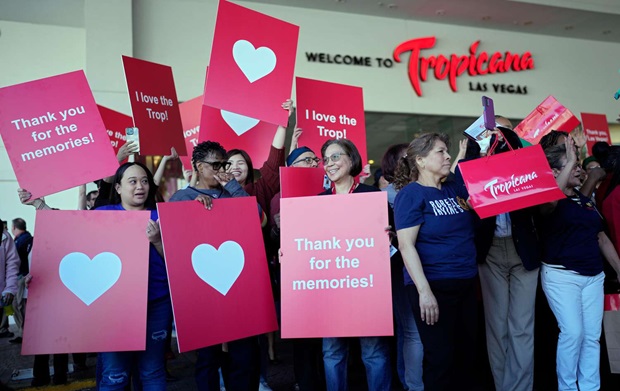In the 1971 film “Diamonds Are Forever,” James Bond stays in a swanky suite at the Tropicana Las Vegas.
“I hear that the Hotel Tropicana is quite comfortable,” Agent 007 says.
It was the Tropicana’s heyday. The lavish casino was a frequent haunt of the legendary Rat Pack, while its past under the mob cemented its place in Vegas lore.
But after welcoming guests for 67 years, the doors to the Las Vegas Strip’s third-oldest casino will be chained shut at noon Tuesday and demolition is slated for October to make room for a $1.5 billion Major League Baseball stadium — part of the city’s latest rebrand as a hub for sports entertainment.
“It’s time. It’s run its course,” Charlie Granado, a bartender at the Tropicana for 38 years, said of the casino’s closure. “It makes me sad but on the other hand, it’s a happy ending.”
The population of Clark County, which includes Las Vegas, had just surpassed 100,000 when the Tropicana opened on a Strip surrounded by a vast, open desert. It cost $15 million to build three stories with 300 rooms split into two wings.
Its manicured lawns and elegant showroom earned it the nickname “Tiffany of the Strip.” There was a towering tulip-shaped fountain near the entrance, mosaic tiles, and mahogany-paneled walls throughout.
Black and white photographs from that time give a view into what it was like inside the Tropicana at its height when it frequently hosted A-list stars in its showroom — from Elizabeth Taylor and Debbie Reynolds to Frank Sinatra and Sammy Davis Jr.
Mel Tormé and Eddie Fisher performed at the Tropicana. Gladys Knight and Wayne Newton have held residencies there.
In a city known for reinvention, the Tropicana itself underwent major changes as Las Vegas evolved. Two hotel towers were added in later years. In 1979, a $1 million green-and-amber stained glass ceiling was installed above the casino floor.
Barbara Boggess was 26 when she started working at the Tropicana in 1978 as a linen room attendant.
“The Tropicana was pretty much sitting here all by itself,” Boggess said. “It was desert all around. It used to take me 10 minutes to get to work. Now it takes an hour.”
Now 72, Boggess has seen the Tropicana through its many iterations. There was the 1980s rebrand as “The Island of Las Vegas,” with a swim-up blackjack table at the pool, and the South Beach-themed renovation completed in 2011.
Today, only the low-rise hotel room wings remain of the original Tropicana structure. Yet the casino still conjures up vintage Vegas nostalgia.
“It does give an old Vegas vibe. When you first walk in, you see the stained glass and the low ceilings,” JT Seumala, a Las Vegas resident who visited the casino in March, said. “It does feel like you step back in time for a moment.”
Seumala and his husband stayed at the Tropicana as a way to pay tribute to the landmark. They roamed the casino floor and hotel, turning down random hallways and exploring the convention center. They tried their luck at blackjack and roulette and made conversation with a cocktail server who had worked there for 25 years. At the end of their stay, they pocketed a few red $5 poker chips to remember the casino.
Behind the scenes of the casino’s opening decades ago, the Tropicana had ties to organized crime, largely through reputed mobster Frank Costello.
Weeks after the grand opening, Costello was shot in the head in New York. Police found in his coat pocket a piece of paper with the Tropicana’s exact earnings figure. The note also mentioned “money to be skimmed” for Costello’s associates, according to a post on The Mob Museum’s website looking back on the Tropicana’s history.
By the 1970s, federal authorities investigating mobsters in Kansas City charged more than a dozen mob operatives with conspiring to skim nearly $2 million in gambling revenue from Las Vegas casinos, including the Tropicana. Charges connected to the Tropicana alone resulted in five convictions.
But the famed hotel-casino also saw many years of mob-free success. It was home to the city’s longest-running show, “Folies Bergere.” The topless revue, imported from Paris, featured what is now one of the most recognizable Las Vegas icons: the feathered showgirl.
During its nearly 50-year run, “Folies Bergere” featured elaborate costumes and stage sets, original music that at one time was played by a live orchestra, line dancers, magic shows, acrobats, and comedy.
The cabaret was featured in the 1964 Elvis Presley film “Viva Las Vegas.” Magicians Siegfried Fischbacher and Roy Horn got their start in the show.
Today, the site at the south end of the Las Vegas Strip intersects with a major thoroughfare named for the Tropicana. It is surrounded by the towering megaresorts that Las Vegas is now known for.
But nearby are the homes of the NFL’s Las Vegas Raiders, who left Oakland, California, in 2020, and the city’s first major league professional team, the NHL’s Vegas Golden Knights.
The ballpark planned for the land beneath the Tropicana is expected to open in 2028.
“There’s a lot of controversy as far as if it should stay or should it go,” Seumala said. “But the thing that I do love about Vegas is that it’s always reinventing itself.”
San Miguel Times
Newsroom

